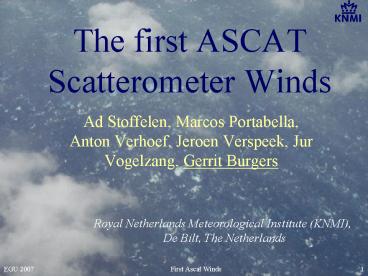The first ASCAT Scatterometer Winds - PowerPoint PPT Presentation
1 / 18
Title:
The first ASCAT Scatterometer Winds
Description:
Aft-fore axis symmetry correction. Horizontal projection for WVC #42 ... CMOD5.5 is better fitted due to the symmetrical scaling of fore and aft measurements. ... – PowerPoint PPT presentation
Number of Views:55
Avg rating:3.0/5.0
Title: The first ASCAT Scatterometer Winds
1
The first ASCAT Scatterometer Winds
- Ad Stoffelen, Marcos Portabella, Anton Verhoef,
Jeroen Verspeek, Jur Vogelzang, Gerrit Burgers
Royal Netherlands Meteorological Institute
(KNMI), De Bilt, The Netherlands
2
ASCAT scatterometer
MetOp-A Launch 19 October 2006
3 antennas aft, fore and mid
3
Continuity of scatterometers
4
First Winds on 27 October 2006
ECMWF FG ASCAT ASCAT QC
- Works fine
- Congratulations from ESA, NOAA and NASA HQ
- Room for improvement
ASCAT demonstration wind service since March
28, 2007
5
Coverage
- Three times as much as ERS
- Comparable to Seawinds smaller nominal area but
fewer gaps - because ASCAT C-band sees through rain
Seawinds
ASCAT
20070406 descending
20070406 descending
6
Resolution
Effect of Seawinds resolution
- ASCAT product has 25 km resolution
- 12.5 km product planned
- (needs advanced retrieval techniques)
7
OSI SAF ASCAT product release schedule
Product Coverage Demonstration Operational
25 km Global 2007 2008
12.5 km Global 2008 2009
Coastal 12.5 km Global 2009 2011
Integration of regional EARS products into
global OSI SAF products in 2008
8
Quality
- Accuracy scatterometer 2 m/s (vector
wind)
- Available L1b commissioning sets
- SS 19/10/06 29/01/07
- ZZ 30/01/07 12/01/07
- ZZZ 13/02/07 today
- New set expected in June,
- after full transponder calibration
- Ocean calibration improves quality
9
Relating backscatter to winds
- CMOD5.5
- F (u,v) ? (sf, sa, sm )
- F maps (u,v) on cone
- in s-space
- F depends on elevation
- and azimuth
10
Ocean Calibration, OCfor improving L2 wind
product
- Purpose
- To correct for lack in absolute calibration
- To make ASCAT compatible with ERS product
- To disseminate a demonstration wind product
- Based on ERS heritage
- CMOD5.5, ice model knowledge in ERS ? range
- Continuity of geophysical data set
- Method 4 mappings that scale s s
- Scale such that no bias remains between ASCAT and
ECMWF winds - Use of ice model to further verify OC
- Scale such that ASCAT data lie on CMOD5.5 cone
11
More on OC corrections
- Assume all corrections are backscatter (z)
scaling factors (dB additions) all L1b
calibration changes so far prove to be so - Use ECMWF wind speed bias at every WVC as
absolute wind reference to achieve uniform
quality - Use CMOD5.5 wind speed sensitivity to compute
beam scaling factors at every WVC - Assume that the CMOD5.5 wind speed sensitivity at
8 m/s is representative of the full wind domain
sensitivity (quasi-linear 8 m/s is mean global
speed) - This backscatter data scaling would ideally
provide the same wind PDF for all WVCs after
CMOD5.5 inversion
12
Mid-axis scaling
Vertical cut for WVC 42 (rightmost)
smid
smid
. Upwind . Downwind
. Upwind . Downwind
sf,a
sf,a
Current Level 1b release
KNMI visual correction
- CMOD5.5 is better fitted due to the down scaling
of mid beam measurements
13
Aft-fore axis symmetry correction
Horizontal projection for WVC 42
sa
sa
. Upwind . Downwind
. Upwind . Downwind
sf
sf
Level 1b 1st release
KNMI visual correction
- CMOD5.5 is better fitted due to the symmetrical
scaling of fore and aft measurements
14
Wind speed bias correction
Vertical cut for WVC 42
smid
smid
. Upwind . Downwind
. Upwind . Downwind
sf,a
sf,a
KNMI visualwind correction
KNMI visual correction
- CMOD5.5 is better fitted due to the upward
scaling of measurements
15
Wind speed bias correction
Horizontal projection for WVC 42
sa
sa
. Upwind . Downwind
. Upwind . Downwind
sf
sf
KNMI visual correction
KNMI visualwind correction
- CMOD5.5 is better fitted due to the upward
scaling of measurements
16
Validation against ECMWF
- ASCAT inverted winds do not only have lower and
more uniform bias w.r.t. ECMWF, but also much
lower wind direction SDE (ECMWF ASCAT error)
17
- Validation against observations -
Higher resolution - Closer to the coast -
Better wind quality
Future SAF ASCAT scatterometer RD
18
Concluding remarks
- ASCAT winds close to perfect
- ASCAT demonstration wind service since 28 March
2007 - Calibration and ERS scatterometer compatibility
can be achieved by scaling CMOD5.5 backscatter - After ASCAT L1b transponder calibration, KNMI
will reprocess data and incorporate remaining
biases in CMODx.x - Continuity of current ASCAT L2 wind quality
is guaranteed over this L1b calibration
More info at http//www.knmi.nl/scatterometer/































